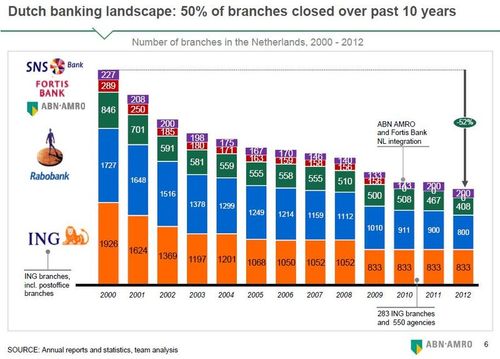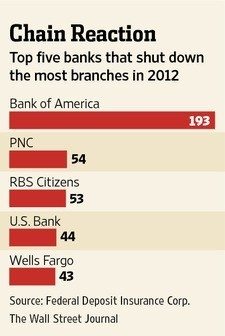
I’ve recently seen so many articles about branches and
branch closures that it’s worth a blog post, just to keep up with the issue.
The first thing that came out was the recent European
Central Bank (ECB) data detailing bank statistics over the past few years.
From analysing this data, Reuters found that there has been significant branch closures, particularly in
austerity countries like Spain:
“Banks have shut about 20,000 branches across Europe in the
last four years, including 5,500 last year and 7,200 in 2011. That represents the closure of about 8% of
Europe's branches since the financial crisis, and the cull is expected to
continue for many years.”
“The cuts have been most severe in Spain, unravelling years
of expansion by regional savings banks, which had landed it with the biggest
network in Europe. Its branch numbers
were down 17% by the end of 2012 from four years earlier. But at just over
38,200 branches, Spain still had more branches per head than any country in
Europe - one for every 1,210 people.”
“France had the most branches in Europe by the end of last
year, with nearly 38,450, or one for every 1,709 people, behind only Spain and
Cyprus per person. Cyprus had one branch
per 1,265 people.”
France “shed less than 3% of its network in the four years
to the end of 2012, while 5% of UK branches and more than 8% of German ones
pulled down the shutters for the last time. The number of branches plummeted by
a third in Denmark and by a quarter in the Netherlands.”
British “banks have almost halved branch numbers since 1990.
Senior bankers privately say a network of 700-800 outlets would be an optimal
size for a bank covering all of Britain. None of the big five have so few.
Lloyds has three times that (2,260), and Royal Bank of Scotland more than twice
(1,750), excluding almost 1,000 branches they are already selling between them.”
British banks closed 557 branches over the last four years resulting
in 11,713 branches in 2012, compared with 12,270 in 2008. Between 2008 and 2011, HSBC closed 181
branches, NatWest 135 and Barclays 99.
The British Bankers Association (BBA) are about to produce a further update to these statistics which will show a
further 68 branches were closed by HSBC in 2012, 60 by RBS/NatWest in the first
half of 2013 and 30 by Barclays. HSBC has announced another 25 closures are anticipated,
as HSBC pushes more focus upon its partnership with Marks & Spencer and banking
through Post Offices.
The figures are more dramatic in the UK if you dig
deeper. According to a recent study by Nottingham
University,
nearly 7,500 branches closed between 1989 and 2012 which would account for 40%
of all branches in Britain.
The USA is the one country that has consistently refuted the
need to close branches, expanding the branch footprint from around 80,000 in
2000 to over 95,000 in 2012. Even there,
we are seeing a final day of reckoning with branches closures rising in the last twelve months.
From a recent article in St Louis Today: “Bank branches in the U.S. fell to 97,337 this year (2013), reflecting a loss of 867 branches in 2012, according to SNL Financial. From 2010 to 2011, branches nationally declined by about 315.”

The writing is on the wall, as illustrated by the
Motley Fool saying that bank branches are going the same way as bookshops and record
stores:
“With a 4% average annual decline in branch traffic over the
past 16 years, banking is the natural next domino to fall … the competition
among online banks, particularly from names like Ally Bank and ING and
Everbank, is likely to cut into margins — but Bank of Internet does have
admirably high Return on Equity (ROE) and a high earnings growth rate compared
to all of the more traditional banks I looked at (their ROE is around 16%, even
great banks like Wells Fargo are down around 13% and most are closer to 10% or
less, sometimes far less.”
I’ve written about this before ...

... and tend to agree with the research by AlixPartners, a New York consulting firm,
who are quoted in the Wall Street Journal as estimating that American banks will cull 1 in 5 branches over the next
decade, putting the total closer in line with 2000 levels.
Perhaps this is further illustrated in the same article by comments from PNC
Financial Services Group President, Wiulliam Demchak. The
Pittsburgh-based bank operates 2,900 branches and are closing 200 this year as the bank’s focus going
forward “will be weighted far more in the direction of technology than teller
lines”. Each time a PNC customer
deposits a check by snapping a picture on a mobile phone, that saves the bank
$3.88 per transaction compared with a deposit at a teller window.
There are other statistics worth noting in the
WSJ article,
such as:
- The number of U.S. branches doubled over the
past three decades, and the industry has reduced branches just three times in
the 77 years since the FDIC started keeping track
- Online banking now accounts for 53% of banking
transactions, compared with 14% for in-branch visits, according to research
from AlixPartners
All in all, the writing is clearly on the wall when you see
the statistic that the Top 30 American banks spend $50 billion a year on their
branches.
This is well illustrated by the Financial Times who state that:
- Bank of America has cut the number of its branches to 5,243
in the third quarter, a 6% decline from the same period last year
- Citigroup has reduced its branches aggressively over the
past seven consecutive quarters, reducing outlets to 3,777 from 4,069 a year
ago

So here’s the bottom-line: if you are not aggressively
looking to migrate customers from physical to digital distribution, then you’re
a dead bank (see Monty Python for more informed
opinion).
A customer enters a bank’s head office.
Mr. Praline: Hello, I wish to register a
complaint.
(The concierge does not respond.)
Mr. Praline: Hello, Miss?
Concierge: What do you mean “miss”?
Mr. Praline: (pause) I’m sorry, I have a
cold. I wish to make a complaint!
Concierge: We’re closing for lunch.
Mr. Praline: Never mind that, my lad. I wish to
complain about this bank branch what I invested in not half an hour ago from
this very bank.
Concierge: Oh yes, the, uh, the Northern Rock...What’s,uh...What’s
wrong with it?
Mr. Praline: I’ll tell you what’s wrong with it,
my lad. It’s dead, that’s what’s wrong with it!
Concierge: No, no, it’s uh,...it’s resting.
Mr. Praline: Look, matey, I know a dead bank
branch when I see one, and I’m looking at one right now.
Concierge: No no it’s not dead, it’s resting!
Remarkable bank, the Northern Rock, isn’t it, ay? Beautiful security!
Mr. Praline: The security doesn’t enter into it.
It’s stone dead.
Concierge: Nononono, no, no! It’s resting!
Mr. Praline: All right then, if it’s resting, I’ll
wake it up! (shouting at the branch) Hello, Mister Money Banks!
I’ve got a lovely fresh pensioner customer for you if you show...
(concierge hits the branch)
Concierge: There, it moved!
Mr. Praline: No, it didn’t, that was you hitting
the wall!
Concierge: I never!!
Mr. Praline: Yes, you did!
Concierge: I never, never did anything...
Mr. Praline: (yelling and hitting the branch
repeatedly) HELLO BANKER!!!!! Testing! Testing! Testing! Testing! This
is your nine o’clock alarm call!
(Takes branch and thumps it on the counter. Throws it up
in the air and watches it plummet to the floor.)
Mr. Praline: Now that’s what I call a dead bank
branch.
Concierge: No, no.....No, it’s stunned!
Mr. Praline: STUNNED?!?
Concierge: Yeah! You stunned it, just as it was
wakin’ up! Northern Rocks stun easily.
Mr. Praline: Um...now look...now look, mate, I’ve
definitely had enough of this. That bank branch is definitely deceased, and when
I purchased it not half an hour ago, you assured me that its total lack of
movement was due to it being tired after a prolonged financial crisis.
Concierge: Well, it’s probably pining for the old
days.
Chris M Skinner
Chris Skinner is best known as an independent commentator on the financial markets through his blog, TheFinanser.com, as author of the bestselling book Digital Bank, and Chair of the European networking forum the Financial Services Club. He has been voted one of the most influential people in banking by The Financial Brand (as well as one of the best blogs), a FinTech Titan (Next Bank), one of the Fintech Leaders you need to follow (City AM, Deluxe and Jax Finance), as well as one of the Top 40 most influential people in financial technology by the Wall Street Journal's Financial News. To learn more click here...

